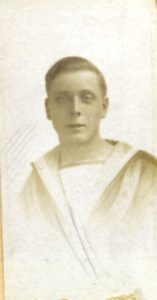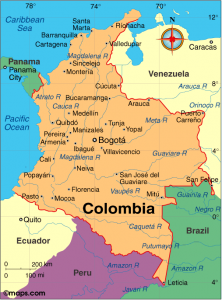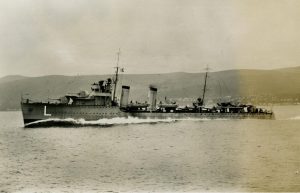- Author
- A.N. Other
- Subjects
- Biographies and personal histories, History - Between the wars
- Tags
-
- RAN Ships
- None noted.
- Publication
- December 2016 edition of the Naval Historical Review (all rights reserved)
As told by his son CMDR Vic Harvey, RAN, Rtd
Fredrick Harold Harvey was a proud Geordie lad, born in Newcastle-upon-Tyne’s suburb of Benwell, on 13 August 1899. Benwell in the West End of Newcastle, with many streets of neat terraced houses, is dominated by its colliery. After leaving school at 14 Fred found work with the tramways and became a tram conductor.
At the time of the Great War on 30 July 1917 he entered the Royal Navy as a Boy Seaman, a month later on his 18th birthday, he signed a 12 year engagement. On entry Fred was only 5 feet 3 inches tall, so he instantly earned the nickname ‘Shorty’, had brown hair, grey eyes and a fresh complexion with a couple of well–earned scars, as Shorty was known for getting into scraps.

Frederick Harvey in naval uniform – Family
At this time there was little shore–side training and his first ship was the formidable looking four-funnel cruiser HMS Powerful, but she was from a past age, had most of her armament removed, and was used as an accommodation ship. He later joined the armoured cruiser HMS Shannon, she had been built pre-war and after Jutland became flagship of a cruiser squadron patrolling in the North Sea. Fred remained in her until she paid off in May 1919. There must have been some action concerning ship salvage as post-war Fred received £4/13/6 in prize money.
It was then off to warmer climes for service with the 3rd Light Cruiser Squadron in the Mediterranean in HMS Centaur. On New Year’s Day 1921 Fred was promoted to Able Seaman. With vast post-war reductions to the fleet Fred had quite a few posting ashore to the training depot HMS Vividat Devonport, which later became better known as HMS Drake.Fred was promoted to Leading Seaman while still in Vividon 10 December 1925 and passed out for Petty Officer on 6 July 1926.
At the time his engagement expired on 12 August 1929 he was serving in the distinctive new battleship HMS Rodney. Her main armament comprised nine 16-inch guns in three turrets, all forward of the bridge. From Rodney Fred was issued with a ‘Gunnery History Sheet’ providing a record of his proficiency in gunnery examinations conducted in all his seagoing ships and a ‘Trade Certificate’ signed by Captain F.L. Tottenham, RN (later Admiral Sir Francis Tottenham). The latter document notes ‘a thoroughly reliable Leading Seaman displaying intelligence, energy, initiative and power of command’.
In 1926 Fred married childhood sweetheart Dorothy Elaine Rodgers and they set up house in Plymouth where the first of two boys, Frederick Harold, was born in 1927. But 1929 was not the best of times to be leaving the comfort and security of the Royal Navy with the Great Depression beginning to cast an ominous shadow over industrial England. With little prospect of work the family migrated to Windsor in Ontario where they had relatives. While some work was found conditions in Canada were not much better than England and the harsh winters did not suit Mum especially with young Victor Edward coming along in 1931. The next year they returned to Plymouth.
South America
In the 1920s the Admiralty authorised the establishment of British Naval Missions in various countries with the aim of providing training and support with increased cooperation through targeted ship visits. This in turn aimed to demonstrate British technical expertise and encourage foreign shipbuilding orders.
In 1932 a conflict erupted between Colombia1and neighbouring Peru regarding a border dispute in the region of the Amazon River. This led to the re–establishment of a Colombian naval service, which had previously been disbanded. A Royal Naval Mission was quickly dispatched to assist the Colombians. This was mainly in response to a potential ‘Red Threat’ with Peru acquiring two older Russian destroyers, renamed Almirante Villar and Almirante Guise, from the politically unstable Republic of Estonia in 1933. Colombia is strategically placed between South and Central America with many neighbours and responsibility for its naval waters over both the Atlantic (Caribbean) and Pacific oceans. In this instance the Peruvians, with their naval forces based only on the Pacific coast, sailed a task force into the Atlantic – so the threat was real.
 Post WWI the Admiralty invited requests from British shipyards for new destroyer designs. The winning designs were from Yarrow and Thorneycroft resulting in the construction of one ship from each yard, HM Ships Ambuscade and Amazon. A year after commissioning in 1928 these ships were sent on a cruise around South America, which included calls at Colombia and Peru, and home via Panama and the West Indies.
Post WWI the Admiralty invited requests from British shipyards for new destroyer designs. The winning designs were from Yarrow and Thorneycroft resulting in the construction of one ship from each yard, HM Ships Ambuscade and Amazon. A year after commissioning in 1928 these ships were sent on a cruise around South America, which included calls at Colombia and Peru, and home via Panama and the West Indies.
The Washington Naval Treaty of 1922 called for significant reductions in naval tonnage resulting in the Royal Navy having no suitable ships to offer Colombia. However a class of six new destroyers based on the Ambuscade design was being built for the Portuguese Navy. The first quarter of the 20th century was tumultuous in Portuguese politics as Britain’s oldest ally transitioned from a catholic monarchy to a socialist republic, cumulating in a 1926 military coup. Despite this two ships were built in Britain (NRP Vouga and Lima) and the remainder in Portugal.
With British assistance two of the Portuguese built vessels were purchased off the stocks by the Armada Nacional Republica de Colombia (ANC) and renamed Antioquia and Caldas. The Portuguese then built two further replacement ships. Royal Naval support was provided in commissioning, storing, manning and working up these vessels.
Leading Seaman Frederick Harvey joins the Colombian Naval Service
A recruitment campaign was undertaken in England to help man the two new destroyers. No mean perk for those in the know, with a two year contract being offer on very similar conditions to service to those afforded under Kings Regulations & Admiralty Instructions (KRAI) which included medical cover, insurance and death benefits. The real incentive, in these times of grave unemployment, was 33⅓% additional pay in £stg for an equivalent RN rank. While this was a single man’s posting, at the completion of the contract a fully paid return passage to England was provided, plus an additional two months pay in lieu of leave.

Glasgow
On 23 February 1934 a formal ‘Contract for Ratings’ (written in English) was entered into between the Chargé d’Affaires of Colombia representing the Government of Colombia and Frederick Harold Harvey. This was witnessed by a Royal Naval officer. On New Year’s Day 1935 another bonus was received with Fred promoted to Petty Officer.
There is an interesting aside in the report of a football (soccer) match between the two ships when working up. This notes that Antioquia’s goalkeeper ‘Shorty Harvey’ accidentally collided with an opposing player with the result that Shorty lost most of his teeth but with true British grit he continued playing with his ship winning 5 – 1. Shorty was not carted off to hospital until the end of the game.
Eventually both new destroyers reached their home port of Cartagena in Colombia on 14 May 1934. They were more of an insurance policy as the dispute with Peru had been settled before their arrival. We are not aware of Fred’s service in country but it does not appear to have been arduous and, strictly in accordance with his contract, he returned home on 22 February 1936. Upon return, with tales to tell and employment gradually improving, Fred became a postman in his native Newcastle. He also joined the RNR.
Had Fred remained in Antioquia he might have seen some unusual action. On 21 January 1936 on the occasion of the death of King George V the Bermuda Militia Artillery were instructed to fire a ceremonial salute from their 4.7-inch gun battery. This salute consisted of 70 blank rounds – one for every year of the sovereign’s life. Because of damp storage conditions there were insufficient blanks so the shortfall was substituted with life rounds fired at maximum elevation. As they opened fire the gunners were unaware that Antioquia was making for the Royal Naval Dockyard, where she was scheduled for refit. Although straddled the ship was not damaged.
Once more with the outbreak of war in 1939 Fred volunteered for naval service but was knocked back. This did not stop him from joining the Army as a private. Now over forty years of age he remained in the United Kingdom, mainly employed as a Batman/Driver to a senior officer based in Scotland.
After the war Fred was welcomed back into the Post Office where he worked as a driver until the time of his death in 1963. He is buried in Newcastle. His widow Dorothy came to Australia and lived with her son Victor and his wife Connie until her death in 1986. The eldest son Frederick Harold (junior) with his wife Violet migrated to Canada where they made successful business careers and raised two children. Finally younger son Vic continued the family tradition, joined the Andrew and, with many years of distinguished service in the RAN … but that is another story.
Notes:
- 1. In terms of population, present day Colombia, with a population in excess of 49 million, is the second largest country in South America.




